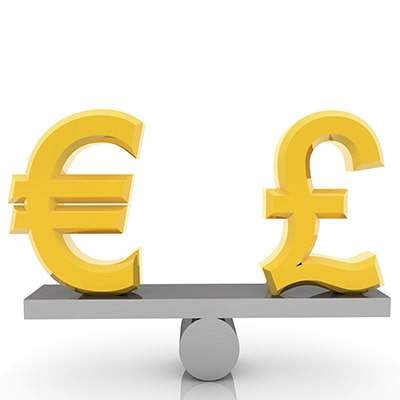All About Trading Currency Cross Rates
The trending nature of currency cross rates can be used advantageously in currency trading. Discover more about it with Queensway.

Crossing Rates
Perhaps the most basic element involved in currency trading is the fact that all currencies trade against each other in forex pairs. Majors all have the U.S. Dollar as either the base or counter currency, while the ones that do not include the U.S. Dollar are commonly referred to as currency cross rates, or simply crosses.
Base Currency vs. Counter Currency
When looking at a forex pair, identifying the base and counter currencies is fairly simple.
The base currency is the one which is subject to being bought or sold and is shown as the first currency in a pair (the one on the left in a currency quote). It also defines the notional amount of the trade.
The counter currency, on the other hand, consists of the units of currency with which the base currency is being bought and sold, and it appears as the second one in the pair (the one on the right in a forex quote). This currency is also used to determine price fluctuations and how your profits and losses are denominated.
For example, in the EUR/AUD pair, the base currency is the Euro (EUR), which is being bought or sold against the Australian Dollar (AUD), which is the counter currency.
If you buy the EUR/AUD pair and it goes up, this indicates that the Euro has gained in value, more Australian dollars are required to buy it or will be received in return for selling it, and you will make a profit that will be denominated in AUD (not in EUR)
Forex Crosses
Majors are forex pairs that include the U.S. Dollar. Cross rates represent all pairs that exclude the U.S. Dollar.
Despite being less liquid than major forex pairs, crosses can still offer Forex traders ample trading opportunities.
Most of the significant currency cross rates have dedicated Interbank brokers or market makers and are divided into Major Crosses and Minor Crosses.
- The Major Crosses include the following pairs:
EUR/CHF – Euro versus Swiss Franc - EUR/GBP – Euro versus British Pound Sterling
- EUR/JPY – Euro versus Japanese Yen
- GBP/JPY – British Pound Sterling versus Japanese Yen
The Minor Crosses include the less active cross rates and generally do not have dedicated market makers and dealers on the Interbank. Despite the lower liquidity and wider bid/ask spreads, minors tend to follow prolonged trends and can offer long-term traders significant opportunities.
- The Minor Crosses include:
AUD/CHF – Australian Dollar versus Swiss Franc - AUD/JPY – Australian Dollar versus Japanese Yen
- CAD/CHF – Canadian Dollar versus Swiss Franc
- CAD/JPY – Canadian Dollar versus Japanese Yen
- CHF/JPY – Swiss Franc versus Japanese Yen
- EUR/AUD – Euro versus Australian Dollar
- EUR/CAD – Euro versus Canadian Dollar
- EUR/NZD – Euro versus New Zealand Dollar
- GBP/AUD – Great Britain Pound Sterling versus Australian Dollar
- GBP/CAD – Great Britain Pound Sterling versus Canadian Dollar
- GBP/CHF – Great Britain Pound Sterling versus Swiss Franc
- GBP/NZD – Great Britain Pound Sterling versus New Zealand Dollar
- NZD/CHF – New Zealand Dollar versus Swiss Franc
- NZD/JPY – New Zealand Dollar versus Japanese Yen
Some brokers also offer trading on exotic pairs that usually involve currencies from developed, emerging or developing countries, where trading activity isn’t very high. They might not be the best pairs to start trading with, as they often have large spreads and lower liquidity. An example is the EUR/TRY (Euro versus Turkish Lira).

Pros and Cons for Trading Currency Cross Rates
By trading different types of forex pairs, you can take advantage of more trading opportunities.
Of course, trading cross forex pairs involves certain costs (often higher than trading majors), but the associated benefits can help generate additional profits through opportunities with larger price movements.
Bear in mind that the most important fundamental factors to follow in the Forex market are the decisions of central banks. This is because the currency market is mainly driven by interest rates.
Therefore, all statistics that are important to central bankers in making their monetary policy decisions are significant for the FX trader. The most important economic data to follow are figures linked to inflation, growth, employment and consumption. These figures can help determine the health of a given economy and the trend its currency will follow, depending on the cost and the availability of its currency.
When trading cross rates, it is important to consider that these currencies display more pronounced and easily discernible trends than the major forex pairs. This trending quality allows the trader to hold positions for a longer period of time and with a higher relative degree of success than holding positions in the majors.
Nevertheless, due to the way crosses are calculated, as well as their trending quality and their lower liquidity, dealers and market makers tend to make their bid/offer spreads significantly wider. This puts the short-term cross trader at an immediate disadvantage, as it will increase their trading costs.
Despite having to pay the larger bid/offer spread, once a position in a cross rate is established on the correct side of the trend, the trader stands to reap the benefits of holding the position over the long run.
In conclusion…
Traders should also take Forex correlation into account in order to avoid being too exposed to a single economy. For instance, if most of one’s trading positions have pairs involving the EUR as the base currency, then all positions will tend to rise and fall at the same time when the EUR strengthens or weakens against its counterparts.
By taking correlation into account, the trader can apply better diversification to mitigate risks while trading currencies, especially when using pairs without the USD.





